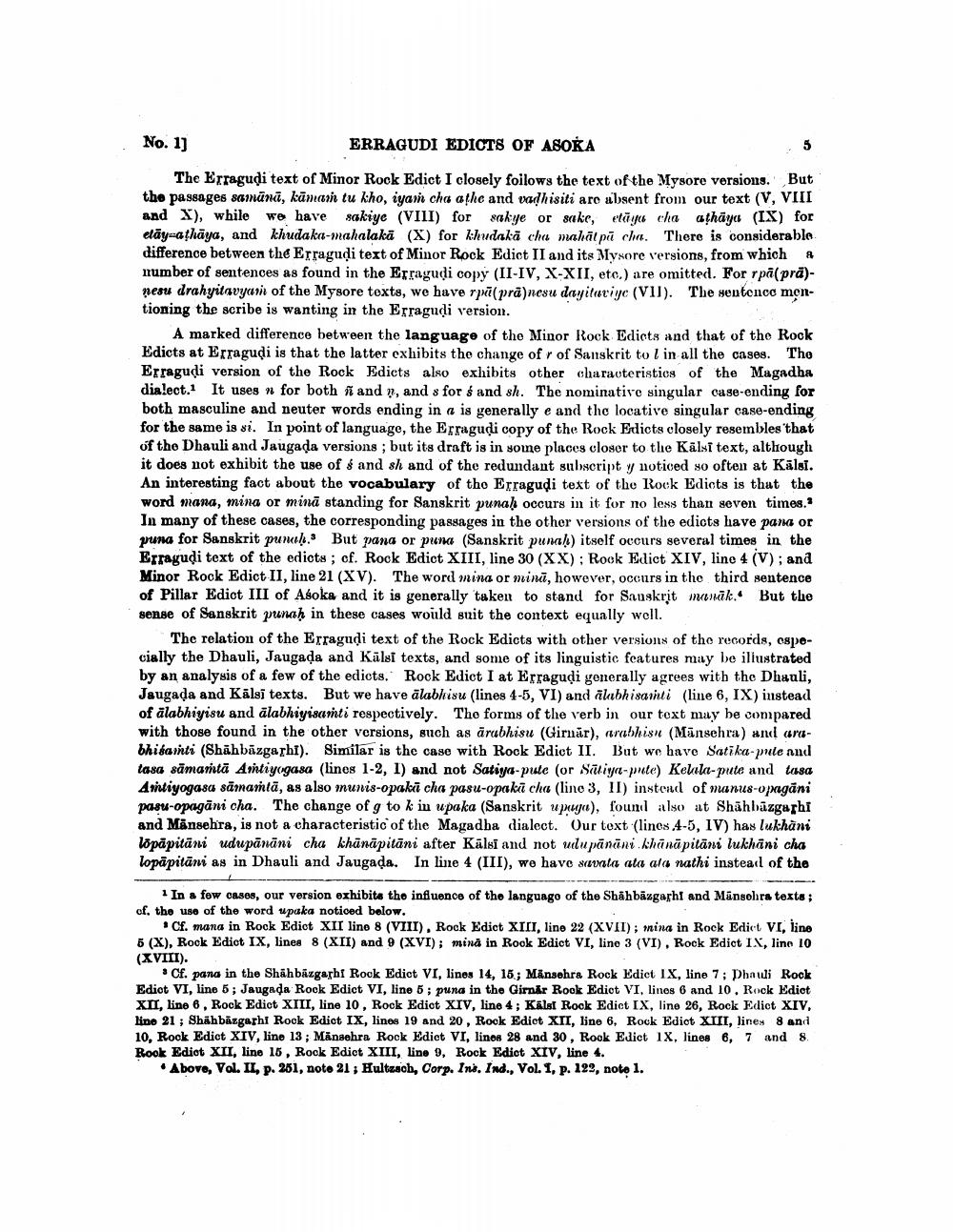________________
No. 1)
ERRAGUDI EDICTS OF ASOKA
The Erragudi text of Minor Rook Edict I closely foilows the text of the Mysore versions. But the passages samūnā, kāmam tu kho, iyam cha athe and vadhisiti are absent from our text (V, VIII and X), while we have sakiye (VIII) for sakye orsake, etäyu cha athāya (IX) for etāy-athāya, and khudaka-mahalaka (X) for khudaka cha mahätpä сht. There is considerable difference between the Erragudi text of Minor Rock Edict II and its Mysore versions, from which mumber of sentences as found in the Errayudi copy (II-IV, X-XII, etc.) are omitted. For rpā(pra)nesu drahyitavyari of the Mysore texts, we have rpi(pra)nesu dayituriye (VII). The sentencc mentioning the scribe is wanting in the Erragudi version.
A marked difference between the language of the Minor Rock Edicts and that of the Rock Edicts at Erragudi is that the latter exhibits the change of r of Sanskrit to l in all the cases. The Erragudi version of the Rock Edicts also exhibits other characteristics of the Magadba dialect. It uses n for both ñ and ?, and s for śand sh. The nominative singular case-ending for both masculine and neuter words ending in a is generally e and the locative singular case-ending for the same is si. In point of language, the Erragudi copy of the Rock Erdicts closely resembles that of the Dhauli and Jaugada versions, but its draft is in some places closer to the Kälsi text, although it does not exhibit the use of sand sh and of the redundant subscript y noticed so often at Kälsi. An interesting fact about the vocabulary of the Erragudi text of the Rock Edicts is that the word mana, mina or minā standing for Sanskrit punah occurs in it for no less than seven times.' In many of these cases, the corresponding passages in the other versions of the edicts have pana or puna for Sanskrit purih. But pana or puna (Sanskrit punal) itself occurs several times in the Erragudi text of the edicts; cf. Rock Edict XIII, line 30 (XX): Rook Edict XIV, line 4 (V); and Minor Rock Edict II, line 21 (XV). The word mina or minā, however, occurs in the third sentence of Pillar Ediot III of Asoka and it is generally taken to stand for Sanskrit memāk.But the sense of Sanskrit punah in these cases would suit the context equally well.
The relation of the Erragudi text of the Rock Edicts with other versions of the records, cspcially the Dhauli, Jaugada and Kälsi texts, and some of its linguistic features may be illustrated by an analysis of a few of the edicts, Rock Edict I at Erragudi generally agrees with the Dhauli, Jaugada and Kälsi texts. But we have alabhisu (lines 4-5, VI) and alabhisanti (line 6, IX) instead of alabhiyisu and alabhiyisanti respectively. The forms of the verb in our text may be compared with those found in the other versions, such as ārabhisu (Girnar), arabhisu (Mansehra) and arabhisanti (Shahbāzgashi). Similar is the case with Rock Edict II. But we have Satika-prile and tasa sāmartā Amtiyogasa (lines 1-2, I) and not Satiya-pute (or Swiya-pute) Keula-pute and tasa Amtiyogasa samantā, as also munis-opaka cha pasu-opaka cha (line 3, II) instead of manus-opagāni pasu-opagāni cha. The change of g to k in upaka (Sanskrit upuga), found also at Shāhbāzgarhi and Mänsehira, is not a characteristic of the Magadha dialect. Our text (lines 4-5, 1V) has lukhāni loppitāni udupānāni cha khānapitāni after Kalsi and not wilu panāni Khanā pitāni lukhani cha lopäpitāni as in Dhauli and Jaugada. In line 4 (III), we have savala ata ala nathi instead of the
1 In a few cases, our version exhibits the influence of the language of the Shahbazgashi and Mansehra texts ; of, the use of the word upaka noticed below.
. Cf. mana in Rock Edict XII line 8 (VIII), Rock Edict XIII, line 22 (XVII); mina in Rock Edict VI, line 5 (X), Rock Edict IX, lines 8 (XII) and 9 (XVI); mină in Rook Edict VI, line 3 (VI), Rock Edict IX, line 10 (XVIII).
* Of. pana in the Shahbâzgahl Rook Edict VI, lines 14, 15; Mänsehra Rock Edict IX, line 7: Dhawi Rock Ediot VI, line 5; Jaugada Rock Edict VI, line 5; puna in the Girnar Rook Ediot VI, linos 6 and 10. Rock Edict XII, line 6, Rock Edict XIII, line 10, Rock Edict XIV, line 4 ; Kálst Rock Edict IX, line 26, Rock Edict XIV, line 21 ; Shahbāzgarhi Rock Edict IX, linos 19 and 20, Rock Edict XII, line 6, Rock Edict XIII, lines 8 and 10, Rock Edict XIV, line 13; Mansehra Rock Edict VI, linos 28 and 30, Rook Edict 1X, lines 6, 7 and 8. Rook Edict XII, line 18 , Rock Edict XIII, line 9, Rock Edict XIV, line 4.
. Above, Vol. II, p. 281, noto 21; Hultaach, Corp. Ind. Ind., Vol. 1, p. 122, noto 1.




